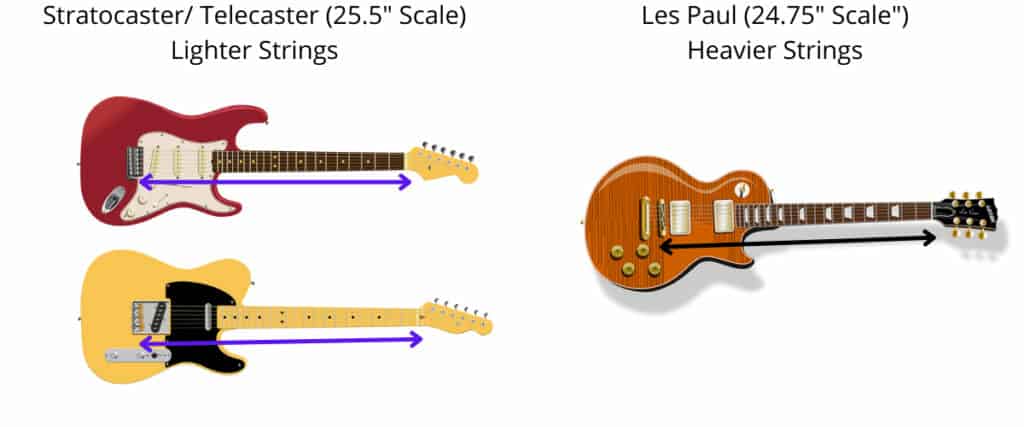The two most popular electric guitar string gauges are 9s and 10s, but which is the best option? In this article I’ll directly compare these two string sizes so you can figure out which is the best option for your electric guitar.
Here’s the quick answer…
Lighter 9-gauge strings are easier to fret and bend compared to thicker 10-gauge strings which are under more tension. Thinner 9-gauge strings suit guitars with a longer scale length (e.g. Stratocasters and Telecasters) whereas 10-gauge strings suit guitars with a short scale length (e.g. Les Pauls).
| 9-Gauge | 10-Gauge |
| Lower tension | Higher tension |
| Best for longer scale length guitars | Best for shorter scale length guitars |
| Good for beginners | Better for drop tuning |
| Sound brighter and thinner | Sound louder and warmer |

String Gauge 101
The gauge of a string refers to the thickness measured as 1/1000th of an inch. Since all the strings in a set have a different thickness, the high E string is used as a reference point. This is the thinnest string in the set.
The most common string sets for an electric guitar are 9-gauge and 10-gauge. The “9” or “10” refers to the thickness of the high E string which will either be 0.009″ (9-gauge) or 0.010″ (10-gauge).
Here are the thicknesses of each string in a standard 9-gauge and 10-gauge pack.
9-Gauge String Set:
- Low E: 0.042″
- A: 0.032″
- D: 0.024″
- G: 0.016″
- B: 0.011″
- High E: 0.009″
10-Gauge String Set:
- Low E: 0.046″
- A: 0.036″
- D: 0.026″
- G: 0.017″
- B: 0.013″
- High E: 0.010″
As you can see, the strings get thicker as you go from the high E to the low E string. In the case of the 9-gauge set, the thicknesses vary from 0.009″ to 0.042″. This is why a 9-gauge pack of strings may also be referred to as a 0.009-0.042″ set, or even a 9-42 set for simplicity.
With a 10-gauge pack, the strings vary from 0.010″ to 0.046″ thick so the pack can be called a 0.010-0.046″ set or a 10-46 set.
When comparing the 9 and 10-gauge sets, you’ll notice that all the strings in the 10-gauge set are thicker. The thickness differences varies from 0.001″ (on the high E string) to 0.004″ (on the low E and A strings). Here’s a table comparing the differences in thickness.
| String | 9-Gauge Set Thickness | 10-Gauge Set Thickness | Thickness Difference | Percentage Increase |
| Low E | 0.042” | 0.046” | 0.004” | 9.5% |
| A | 0.032” | 0.036” | 0.004” | 12.5% |
| D | 0.024” | 0.026” | 0.002” | 8.5% |
| G | 0.016” | 0.017” | 0.001” | 6.0% |
| B | 0.011” | 0.013” | 0.002” | 18.0% |
| High E | 0.009” | 0.010” | 0.001” | 11.0% |
As you can see from the table above, the strings on a 10-gauge set are between 6% and 18% thicker compared to the 9-gauge set. The biggest percentage difference can be seen on the B and A strings, and the smallest percentage difference can be observed on the G and D strings.

Difference Between 9 and 10-Gauge Strings
Okay so now we’re clear about the sizes of each string and the different ways they may be named from brand-to-brand, let’s get into the practical and tonal differences between them.
Lighter 9-gauge strings are under less tension compared to heavier 10-gauge strings. This has an impact on the following:
- Feel and playability
- Guitar suitability
- Tuning stability
- Tone
Let’s take a look at each of these factors individually.
Feel and Playability
The thickness of a guitar string has a significant impact on how it feels to play.
Heavier 10-gauge strings require more finger strength to fret and bend compared to lighter 9-gauge strings which are easier to push down on and bend. This is because 10-gauge strings are under more tension.
In terms of which option is best out of the two depends on your personal preference and which guitar you’re playing (more on this in the next point).
Beginners often prefer the feel of lighter 9-gauge strings because they are easier to hold down, whereas 10-gauge strings often feel a bit more difficult. Players who suffer from joint pain in their fingers are also likely to prefer the feel of 9-gauge strings.
However, some people prefer the sturdier feeling of 10-gauge strings if they have stronger fingers, especially when trying to bend the strings as they’re less likely to wildly bend them out of tune due to the lower tension.
Lighter strings are often favoured for lead-guitar playing as they’re easier to bend and fret which is useful for fast single-note playing. Even some rhythm players prefer lighter strings as they can make barre chords less taxing.
Guitar Suitability
Guitars with a shorter scale length suit thicker strings, whereas guitars with a longer scale length suit thinner strings. Scale length refers to the distance between the bridge and the nut of a guitar.
With a shorter scale length, the strings are under less tension. In order to compensate for the weaker tension, shorter scale guitars are often fitted with heavier gauge strings because they will create more tension.
Conversely, a longer scale length puts the strings under more tension, so in order to prevent the tension being too high, thinner strings are used on the guitar.
Let’s take two famous guitars as an example, the Les Paul and Strat.
- The Les Paul has a scale length of 24.75″ and comes with 10-gauge strings as stock
- The Strat has a scale length of 25.5″ and comes with 9-gauge strings as stock
That’s not to say that you can’t put lighter strings on a 24.75″ Les Paul, or heavier strings on a 25.5″ Strat, but it does mean that it’ll affect the feel and playability significantly.
Considering the scale length when determining the suitable string thickness is important as it ensures the strings are not under too much/ too little tension which impacts the feel and playability as discussed in the previous section.

Check out my article comparing 24.75″ and 25.5″ scale guitars to learn more.
Tuning Stability
One reason why you may want to go with thicker 10-gauge strings over thinner 9-gauge strings is because they offer more tuning stability. The thicker 10-gauge strings are under more tension meaning it’s harder to pull the guitar out of tune.
The difference isn’t massive though when comparing a set of 9s and 10s in standard tuning. It’s best to keep feel and playability as the main factor to consider when choosing the string gauge.
If you are having issues with tuning instability then check out this article I’ve written on 8 reasons why your guitar keeps going out of tune and how to fix it.
However, the difference can become more significant when drop tuning. Drop-tuning the strings will reduce the tension as they loosen up. Using heavier 10-gauge strings is better here as they will compensate for the reduced tension.
Tone
Thicker 10-gauge strings sound louder, warmer and offer more sustain compared to thinner 9-gauge strings which sound brighter and quieter.
This is because the heavier strings produce more low-end (bass) frequencies which helps to create that warmer tone with plenty of sustain. Thinner strings sound a bit brighter and thinner, which may be useful for some music styles such as country.
Check out this YouTube video to hear the difference between 9-gauge and 10-gauge strings.
However, I’d advise against choosing your string gauge based on the tone in a lot of cases. This is because the string gauge has a big impact on the feel of the guitar, and you can always adjust your amp to tweak the tone.
The difference that the string thickness has on the tone is also very subtle and difficult to decipher unless you’re hearing both sets back to back. It’s also only really noticeable to a lot of players when using clean amp settings. With high-gain amp settings it’s very hard to detect.
Note on Fret Buzz
Heavier gauge strings are less likely to cause fret buzz compared to lighter gauge strings. This is because thicker strings are under more tension so don’t vibrate as freely and risk touching the fingerboard compared to thinner strings which are able to vibrate in a wider arc. Thicker strings also sit higher in the nut which can reduce the chance of fret buzz.
However, if you’re getting a lot of fret buzz then I’d recommend taking your instrument to a good guitar technician who will be able to advise on the cause and the best fix for it, as in a lot of cases the answer will not be simply switching to thicker strings.
Which String Gauge is Best?
There isn’t a “best” string gauge out of these two options, but there are some situations where one string gauge may be more suitable to most people than others.
Here are some generalisations to consider.
| Scenario | “Best” String Gauge |
| For a 24.75” scale guitar | 10-gauge |
| For a 25.5” scale guitar | 9-gauge |
| For fast lead-playing | 9-gauge |
| For beginners | 9-gauge |
| For players with joint pain | 9-gauge |
| When drop-tuning | 10-gauge |
The answer to this question is very subjective, so take the table above with a pinch of salt. It’s designed to give you a starting point if you’re really unsure which option to go with.
I would recommend experimenting next time you get your strings changed if you think it may be beneficial to you based on the points discussed in this article. If you currently play with 9-gauge strings, give 10s a try, or vice-versa. This is the only way to really know which string gauge is best for you.
Why Switch to a 10-Gauge Set of Strings?
- If you’re drop-tuning and need to put the strings under more tension
- If you are struggling to control your bends using 9-gauge strings
- If the 9-gauge strings feel too light and sensitive
Why Switch to a 9-Gauge Set of Strings?
- If you find that 10-gauge strings are a bit difficult to fret
- If you want strings that are easier to bend
One final point to keep in mind that just because a set of 10s works best for you on one guitar, it may not work as well for you on another, especially if the scale length is different. This is an important thing to remember if you own multiple guitars.
Check out my comparison between steel, nickel wound and pure nickel strings
